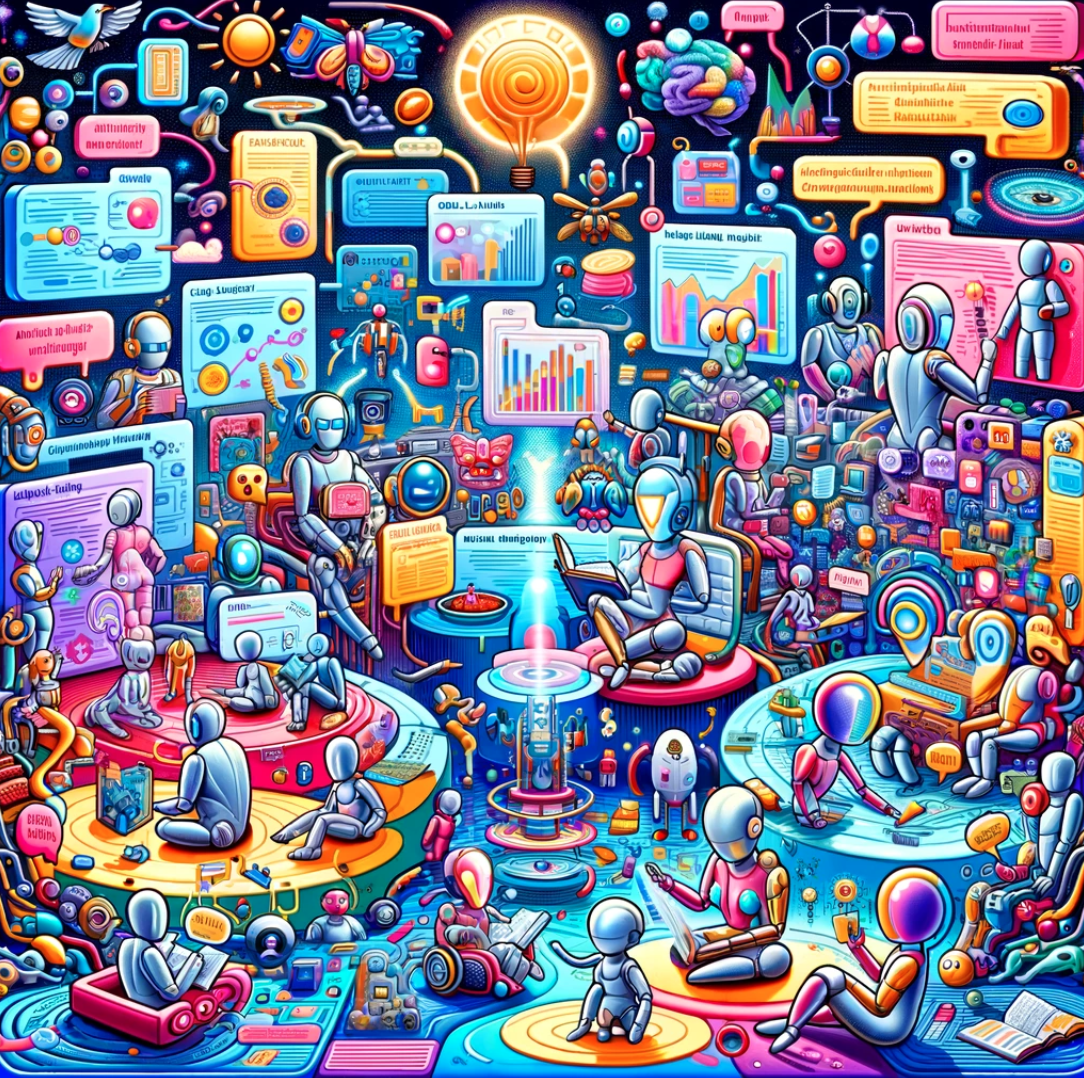The idea of making Large Language Models (LLMs) more agentic is a complex and highly debated topic in AI research.
Here’s a breakdown of the key areas of focus and the challenges involved:
Table of Contents
What is Agentic Behavior?
Before we dive into how, let’s define what we mean by “agentic” LLMs:
- Goal-oriented: Agentic LLMs would actively pursue goals, either intrinsically defined or given by users.
- Proactive: They would take initiative rather than solely reacting to prompts.
- Autonomous: They would exhibit independent decision-making in the pursuit of goals, demonstrating some degree of self-direction.
- World-aware: They would be able to perceive and interact with real-world environments (or sufficiently complex simulations) to gather information, carry out actions, and update their understanding.
How to Enhance Agency in LLMs
Embodiment and Grounding
- Connecting LLMs to sensory inputs and giving them the ability to act upon the world (whether physical or simulated) is crucial. This allows them to learn through experience and develop context-dependent actions.
- Research in robotics and embodied AI would be essential for this direction.
Multimodal Learning
- Currently, LLMs are primarily text-based. Integrating the ability to process and generate images, video, and audio would significantly expand their ability to understand and interact with a wider range of information and tasks.
Goal-directed Reinforcement Learning
- Reinforcement learning (RL) frameworks, where the LLM learns through trial and error guided by rewards, can help develop goal-seeking behaviors.
- However, defining appropriate reward functions becomes a complex, potentially dangerous problem in itself.
Planning and Meta-Learning
- The ability to break down complex goals into sub-tasks and plan sequences of actions would be necessary for complex agency.
- Meta-learning (learning to learn) would help LLMs adapt to new tasks and goals more quickly.
Enhanced Interaction and Communication Capabilities
- Natural Language Understanding and Generation: Advancements in understanding nuances, contexts, sarcasm, and complex instructions in natural language are vital. This includes generating responses that are not only relevant and coherent but also exhibit empathy and adaptability to the user’s emotional state.
- Dialogue Systems: Developing sophisticated dialogue systems that can maintain context over long conversations, remember past interactions, and integrate this information into future responses.
Ethical and Social Implications
- Transparency and Explainability: As LLMs become more agentic, ensuring their decisions and actions are transparent and explainable to users becomes increasingly important. This is crucial for trust and accountability, especially in critical applications.
- Privacy Concerns: The integration of LLMs into more aspects of daily life raises significant privacy concerns. Ensuring that these models respect user privacy and adhere to data protection laws is essential.
- Bias and Fairness: Addressing and mitigating biases in LLMs to ensure fairness across diverse user groups. This includes biases in language understanding, decision-making processes, and interactions.
Integration with Other AI Systems
- Hybrid AI Systems: Combining LLMs with other types of AI models, such as computer vision models for better understanding and interaction with the physical world or decision support systems for more informed and rational decision-making.
- Interoperability: Ensuring LLMs can work seamlessly with existing technological ecosystems, including software applications, IoT devices, and other AI systems.
Sustainability and Accessibility
- Energy Efficiency: Addressing the environmental impact of running large-scale LLMs by developing more energy-efficient computing architectures and algorithms.
- Accessibility: Ensuring that the benefits of agentic LLMs are accessible to a wide range of users, including those with disabilities or those in low-resource settings.
Continuous Learning and Adaptation
- Online Learning: Enabling LLMs to learn from new information and experiences in real-time, allowing them to adapt to changes in their environment or user needs without requiring retraining from scratch.
- Human-in-the-Loop: Developing mechanisms for human oversight and intervention, allowing users to correct, guide, or refine the behavior of LLMs. This is crucial for both safety and alignment with human values.
Long-Term Societal Impact
- Workforce Implications: Understanding and preparing for the potential impact of agentic LLMs on the workforce, including job displacement and the creation of new types of work.
- Ethical Frameworks: Developing comprehensive ethical frameworks to guide the development, deployment, and use of agentic LLMs, considering the potential long-term impacts on society.
These factors highlight the multidisciplinary nature of advancing towards more agentic LLMs, involving not only technical innovations but also deep ethical considerations, societal impact assessments, and policy development.
Each of these areas presents its own set of challenges and opportunities, requiring collaborative efforts across the fields of AI research, ethics, policy-making, and beyond.
Key Challenges
- Safety and Alignment: The more agentic an LLM becomes, the greater the need for robust safety mechanisms and ensuring alignment with human values. Questions of misuse, unintended consequences, and potential control issues become paramount.
- Scalability: Achieving agency will likely require significant increases in model size and computational resources, raising questions of economic and energy feasibility.
- Understanding Consciousness: Attempts to create agentic AI will inevitably lead to questions about whether these systems could develop a sense of self or consciousness, entering highly fraught ethical territory.
Important Considerations
- The Debate: There’s no consensus on whether highly agentic LLMs are even desirable. Many researchers believe the focus should be on making LLMs powerful tools under human control rather than independent actors.
- Incremental Approach: The development of agentic features will likely be gradual, with systems progressing from limited goal-seeking to more complex autonomous behaviors.
- Potential Benefits: Agentic LLMs could revolutionize how we interact with computers and have significant applications in problem-solving, research, and creative domains.
FAQs – How to Make LLMs More Agentic (LLM Agents)
What are the first steps to making Large Language Models (LLMs) more agentic?
The first steps involve clearly defining the goals and scope of agency desired in the LLM.
This includes determining what kinds of decisions the LLM should make independently and what actions it should take in response to various inputs.
Following this, it’s essential to develop or integrate technologies that enable understanding and processing of natural language inputs in a goal-directed manner.
This may involve enhancing the model’s ability to parse and interpret complex instructions and its capacity for long-term memory to maintain context over extended interactions.
Additionally, setting up a framework for safe experimentation and learning, such as simulation environments or sandboxed real-world interactions, is crucial for gradually increasing the model’s agency through controlled exposure to decision-making scenarios.
How can LLMs be programmed to understand and pursue goals?
LLMs can be programmed to understand and pursue goals through the integration of reinforcement learning (RL) techniques and goal-oriented dialogue systems.
By defining specific objectives or rewards that align with desired outcomes, LLMs can be trained to recognize and prioritize actions that lead toward achieving these goals.
This requires creating a mapping between natural language inputs (which describe goals) and the actions or outputs that advance the LLM toward these goals.
Implementing a feedback loop where the LLM receives positive reinforcement for actions that contribute to goal achievement can refine its understanding and effectiveness over time.
What technologies are involved in enabling LLMs to take proactive actions?
Technologies that enable LLMs to take proactive actions include advanced natural language processing (NLP) capabilities, predictive modeling, and context-aware computing.
By understanding the context and history of interactions, LLMs can anticipate needs or questions and provide relevant information or perform tasks without being explicitly asked.
Integrating external data sources and APIs allows LLMs to fetch real-time information or execute actions in external systems, further enabling proactive behavior.
Additionally, employing machine learning models that can predict likely future requests or problems based on past data can help LLMs to prepare or alert users accordingly.
In what ways can LLMs demonstrate autonomous decision-making?
LLMs can demonstrate autonomous decision-making by analyzing complex datasets, generating insights, making predictions, and suggesting actions based on predefined goals and learned preferences.
For example, an LLM can autonomously draft emails, generate reports, or recommend decisions in a business context by understanding the objectives and analyzing the relevant data.
Implementing decision trees, logic rules, and machine learning algorithms enables LLMs to evaluate different courses of action and choose the one most likely to achieve the desired outcome, taking into account the nuances and preferences expressed by the user.
How can we ensure that LLM agents align with user intentions and ethical guidelines?
Ensuring that LLM agents align with user intentions and ethical guidelines requires implementing robust oversight and feedback mechanisms.
This involves setting clear boundaries for the LLM’s actions and decisions, regularly reviewing its performance and the decisions it makes, and incorporating user feedback to correct and refine its behavior.
Establishing ethical guidelines and training the model on datasets that reflect diverse perspectives and values helps mitigate biases and ensure fairness.
Additionally, transparency in the LLM’s decision-making processes enables users to understand how decisions are made, fostering trust and allowing for the identification and correction of misalignments.
What are the challenges in making LLMs world-aware and capable of interacting with complex environments?
Making LLMs world-aware and capable of interacting with complex environments poses several challenges, including the integration of diverse data sources to provide a comprehensive understanding of the world, the development of models that can process and interpret this information in real-time, and the ability to adapt to new and unforeseen circumstances.
Ensuring accurate perception and interpretation of sensory data (in the case of embodied LLMs) and the seamless integration of this data into decision-making processes are also significant challenges.
Additionally, maintaining privacy and security while interacting with external systems and data sources is crucial to prevent misuse and protect user data.


